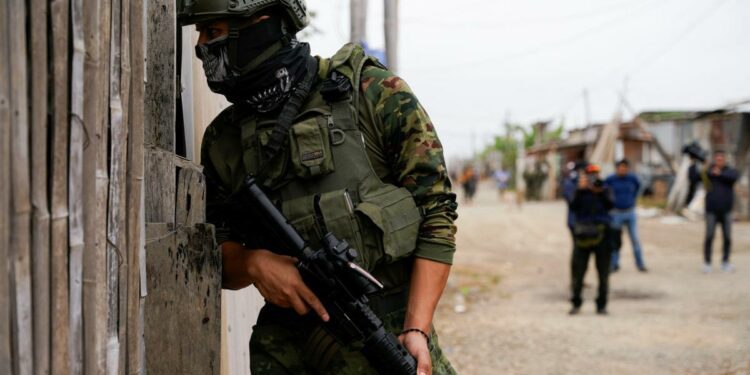Now more than ever, Latin America needs help with its security. In 2023, more than 40 of the world’s 50 most murderous cities were in Latin America and the Caribbean. A lethal mix of readily available firearms; illicit commodities such as drugs, weapons, and illegally mined precious metals; and growing government corruption has dramatically strengthened the region’s transnational gangs, cartels, and Mafias. In Ecuador, drug gangs are using extortion and wanton violence to make the country one of the world’s most violent, contributing to an unprecedented exodus of ordinary citizens.
From the beginning, the Biden administration has elevated the importance of the Western Hemisphere, not least in its 2022 National Security Strategy, which asserts that the region’s pressing problems of democratic erosion, mass migration, environmental degradation, and transnational crime are now matters of U.S. national security. To address the crisis, President Joe Biden pledged to “get to work building the future this region deserves” in 2022. But amid other urgent security concerns, such as Russia’s war in Ukraine and containing China, Washington’s rhetoric about Latin America has not been matched by decisive action. Recent U.S. strategy has focused more on enhancing economic opportunity—by mobilizing private investment, supporting regional entrepreneurs, and extending climate-conscious development loans—than bolstering local security forces. Although economic initiatives can help address joblessness and the incentives of gang affiliation, even more urgent is the task of giving regional police and military forces the training and resources they need to counter the far-reaching security threats that are preventing normal economic life from taking place.
Providing security assistance has long been a technical and political tool of U.S. statecraft. Indeed, the State Department and the Defense Department deliver financial resources, services, hardware, technology, and training to more than two dozen countries in the Americas, helping to strengthen the capability and credibility of the U.S. government’s partners. Yet over the past few years, U.S. aid has failed to meet the scale of the challenge. The United States needs a new game plan for building security partnerships in Latin America and for ending the region’s cycle of violence and disorder. To start, Washington should again embrace the worldview that it can best protect its own security by helping democratic neighbors advance theirs. It can do so by drawing on the lessons of decades of U.S. security policy in the Americas but also by determining how those policies can be revised and improved.
The Western Hemisphere is crucial to U.S. security, but Washington is unlikely to see progress on the region’s problems unless it steps up its own investments in the region’s law enforcement and defense forces.
GUNBOATS AND GUERRILLAS
The United States’ closest neighbors were not always a policy afterthought. In the first decades of the twentieth century, countries in the Caribbean basin received major U.S. military and police aid. In countries such as Cuba, the Dominican Republic, Honduras, Nicaragua, and Panama, Washington provided rifles, mortars, and armored vehicles to autocrats who protected U.S. agribusiness interests in sugar, bananas, and spices. Where security assistance didn’t achieve its intended objectives, Washington invoked the Monroe Doctrine, sending marines to exact local compliance with U.S. policies and to protect U.S. profits. From the War of 1898 to World War II, the United States intervened in this way at least 30 times in Latin America and the Caribbean.
The rules-based international order that followed World War II tempered Washington’s appetite for overt military interventions in Latin America. But during the Cold War, the spread of revolutionary violence in several countries in the region pushed the United States to implement policies designed to contain communist agitation. In the decade following the 1959 Cuban Revolution, the Department of Defense provided $1.7 billion in materiel and counterinsurgency support to sympathetic Latin American armies in an effort to prop up pro-Washington administrations and win local hearts and minds.
Nowhere was security assistance more visible than El Salvador, where the United States invested $6 billion to suppress Marxist insurgents. In 1990, the Salvadoran military was the eighth-largest recipient of U.S. security assistance globally. Although the U.S. aid failed to achieve a battlefield victory and did not end state-sponsored human rights violations, it proved critical in preventing a guerrilla takeover and facilitating a negotiated resolution to more than 12 years of armed conflict. This indirect effort provided a stark contrast to simultaneous U.S. approaches in Haiti, Lebanon, and Panama, where the Pentagon deployed its own peacekeeping and combat troops in a bid to settle volatile political situations. The Salvadoran case showed that the United States could provide a “small footprint” solution to a big geostrategic dilemma and became a reference point for future security aid efforts.
FROM PERIL TO PARTNERSHIP
Two decades after it began its effort in El Salvador, Washington launched Plan Colombia, one of its most ambitious security assistance packages ever. The challenge it set out to address was daunting: in the late 1990s, insurgent, paramilitary, and drug-trafficking groups had rendered Colombia the world’s kidnapping capital and largest cocaine exporter. Plagued by corruption and abuse, the country’s security forces routinely surrendered to adversaries wielding superior weapons financed with drug profits.
Although the initiative would end up costing $10 billion over some 15 years, it mostly worked. In the 12 years following Plan Colombia’s launch, Colombian security forces pushed the country’s illegal armed groups out of cities and deep into the countryside and jungle, enticed the Revolutionary Armed Forces of Colombia (FARC), the country’s largest insurgent group, into historic peace negotiations, reduced the country’s drug crop acreage by more than half, and dramatically curbed crime and violence. As a result, the military and police enjoyed broad support among Colombia’s politicians, its private sector, and the general public.
During the early years of the U.S. initiative, however, the Colombian military committed serious human rights violations. To address this problem, Washington conditioned continued U.S. aid on the Colombian government holding soldiers and police to account for state-sponsored atrocities, a step that helped reduce extrajudicial murders and arbitrary detentions. Between 2008 and 2019, Colombian courts delivered sentences in more than 1,700 cases of serious military and police abuse. Although drug violence in Colombia persists today, the country’s improvements have helped it achieve a coveted free trade deal with the United States, NATO partner status, and admission to the Organization for Economic Cooperation and Development.
But Plan Colombia’s success has proved difficult to replicate. From 2007 to 2021, another U.S. security assistance plan in Mexico, known as the Mérida Initiative, provided U.S. hardware and training for Mexican soldiers, police, judges, and prosecutors, amounting to a $3.5 billion investment with bipartisan backing in the U.S. Congress. But during the project’s 15-year duration, Mexico’s homicide rate surged from eight per 100,000 inhabitants to 28 per 100,000, and drug-trafficking organizations continued to penetrate Mexican institutions at the highest levels.
Plan Colombia demonstrated that U.S. security assistance can succeed when effectively structured. But it also showed that such efforts depend on partner governments complementing U.S. investments with significant national financing, avoiding politicizing security strategies, and professionalizing the uniformed and civilian bureaucracy responsible for implementing security policies. In Mexico, the absence of these features—and the Mexican government’s historically rooted suspicion of U.S. meddling—prevented the Mérida Initiative from achieving stabilization.
WRONG ASSUMPTIONS
After decades of often failed initiatives, U.S. security assistance has become a matter of global scrutiny. Perhaps most glaring was the Taliban’s 2021 takeover of Afghanistan, after Washington had spent 20 years and $83 billion building Afghan security forces. Given this and other setbacks, many observers wonder why such U.S. assistance continues to underdeliver.
The short answer is that context matters. Washington has long adopted a one-size-fits-all approach to security assistance, failing to account sufficiently for differences among recipient nations. Policymakers also too often assume that the United States can buy its way out of foreign crises, but the success of security assistance depends on leaders and organizations that the United States can sometimes influence but rarely control.
U.S. strategists trust that the United States and its friends want the same thing: stable, safe, and prosperous societies. But valued partners sometimes have hidden ambitions that may be at odds with those of the United States, such as the involvement of former Honduran President Juan Orlando Hernández—once thought to be a trusted partner—in drug trafficking. U.S. foreign policy often relies on positive reinforcement in the form of financial aid and political support to induce desired behavior in partner institutions, but security assistance fails to do so when the United States and its partners have divergent interests.
Moreover, by giving local security officials resources, firepower, and credibility, the United States also risks fueling more instability. Such was the consequence when Washington rhetorically supported Haitian Prime Minister Ariel Henry following President Jovenel Moïse’s assassination in 2021. Alternative power blocs rejected Henry and denounced his mandate as treasonous, making it difficult for U.S. policymakers to step up U.S. assistance for stabilizing Haiti amid a crisis in the prime minister’s domestic legitimacy.
Finally, when the United States delivers security assistance to undemocratic partners, as was common during the Cold War, it risks fueling future popular resistance and resentment. The populist left that led Latin America during the early decades of this century corralled regional anti-U.S. sentiment by invoking the bloody history of U.S. imperialism in the Americas. Such public antagonism helped drive Ecuadoran President Rafael Correa to expel U.S. troops from a counterdrug air base in Ecuador in 2009 and Mexican President Andrés Manuel López Obrador to remove diplomatic immunity for U.S. law enforcement officers operating in Mexico in 2020. U.S. support to authoritarian governments in the twentieth century haunts and constrains U.S. policy in the region today.
CHANGE STARTS AT HOME
Although the governments and security agencies on the receiving end provide convenient scapegoats when U.S. security assistance fails, Washington’s own bureaucracy shares the blame. The U.S. government is reactive in authorizing police and military aid to defuse international crises, but security assistance is better at preventing fires than extinguishing them, given that generating institutional change takes time.
Past shortcomings can be partly attributed to the inner workings of the U.S. Congress, which funds security assistance largely through annual appropriations bills. Congress rarely takes a longer generational view, and bureaucratic hurdles frequently postpone the delivery of U.S. aid. Despite allocating $350 million to the Central America Regional Security Initiative from 2008 to 2011, the State Department only deployed some $75 million by 2013 because of congressional delays in passing spending bills.
Coordination among U.S. executive agencies and departments is another challenge. The State Department holds ultimate responsibility for distributing security assistance but lacks the administrative resources to administer such assistance worldwide. Consequently, the Pentagon is routinely given the task of large-scale implementation, which creates interagency inefficiencies because the armed services typically view train-and-equip missions as tangential to their principal tasks of waging war and defending the homeland.
Moreover, the State Department’s diplomatic priorities in a given country or region sometimes run counter to the priorities of the Department of Defense and Drug Enforcement Administration. The botched arrest of General Salvador Cienfuegos Zepeda, Mexico’s former secretary of national defense, by U.S. authorities in 2020 was a case in point: U.S. federal agents spent years building a case against Cienfuegos for drug trafficking and money laundering only for the Department of Justice to drop the charges within a month of his arrest under pressure from Mexico City.
In many cases, the United States must also push the corrupt security forces of partner governments to reform and embrace democratic values even as it leans on those same forces to deliver operational successes. As a result, U.S. partners may choose the extent to which they comply with U.S. preferences, and the United States will find it increasingly challenging to entice military and police partners into values-based cooperation when Chinese and Russian officials offer them “no-strings-attached procurements.”
DEMOCRACY DEFENDED
National security policy develops out of necessity, and the United States rarely has the luxury of choosing its partners when considering the safety of its citizens and national interest. Policymakers therefore need to manage expectations about what Washington can achieve through security assistance given the often varying economic, political, and social forces at play in recipient countries. When possible, the United States should concentrate its resources in places where conditions are most favorable to building sustained progress in its partner police and military institutions.
Enduring U.S. security assistance can catalyze positive national transformation in friendly countries. As the Pentagon increasingly anchors its strategy for competing with global adversaries by strengthening ties with allies, it should encourage and reward partner forces that share its commitments to democracy to strengthen its global network of like-minded governments. For this, Washington should look to the American continent—the second most democratic region of the world and the most vital for the defense of the U.S. homeland. As U.S. policymakers redouble their efforts to stabilize an increasingly volatile neighborhood, they must prioritize boosting the legitimacy and effectiveness of regional governments so that they can work together to counter shared threats to their security.
Washington can best protect its own security by helping its neighbors advance theirs.
To curb corruption and thus strengthen its partners’ capacities to distribute their security funding, the United States should ensure that its investments are accompanied by proper oversight bodies in recipient countries, background checks on public officials who benefit from U.S. aid, and human rights protocols as part of a coordinated, whole-of-government approach to security assistance. These investments should be the foundation for traditional security assistance programs such as hardware and technology transfers.
Effective security forces also require regional justice systems that can prosecute lawbreakers and deter illegal activity. The U.S. government should devote commensurate resources via the State Department and Justice Department to help strengthen and reform judiciaries where impunity prevails and crippling case backlogs delay justice.
Finally, Washington must remove its own bureaucratic barriers to strengthening security ties. Minimizing delivery timelines, committing to multiyear investments, and synchronizing priorities across U.S. government agencies would enhance the United States’ credibility as a reliable partner. Further, the limitations the U.S. government places on security assistance for high-income countries, because of its belief that wealthier nations should shoulder their own security responsibilities, puts the United States at a disadvantage in Latin America: preferred security partners and regional leaders such as Chile, Guyana, Panama, and Uruguay are less able to participate in U.S.-funded programs, even as their own vulnerability to crime and violence is on the rise. Moreover, U.S. adversaries have no such restrictions on assistance.
To make lasting improvements to its security assistance in Latin America and the Caribbean, the United States will need to secure the buy-in of international partners and its own branches of government, especially the U.S. Congress. The long history of U.S. security ties in the region provides a strong foundation for regional enthusiasm for U.S. initiatives. But whether such valuable programs can truly achieve results will depend on whether Washington can learn from past mistakes and overcome the bureaucratic and political limitations that have previously held it back.
Loading…
Source link : http://www.bing.com/news/apiclick.aspx?ref=FexRss&aid=&tid=66ed529bf7ef4d80b4fac1cc969f00af&url=https%3A%2F%2Fwww.foreignaffairs.com%2Funited-states%2Fless-lethal-latin-america&c=919914138967304999&mkt=en-us
Author :
Publish date : 2024-09-10 17:21:00
Copyright for syndicated content belongs to the linked Source.






